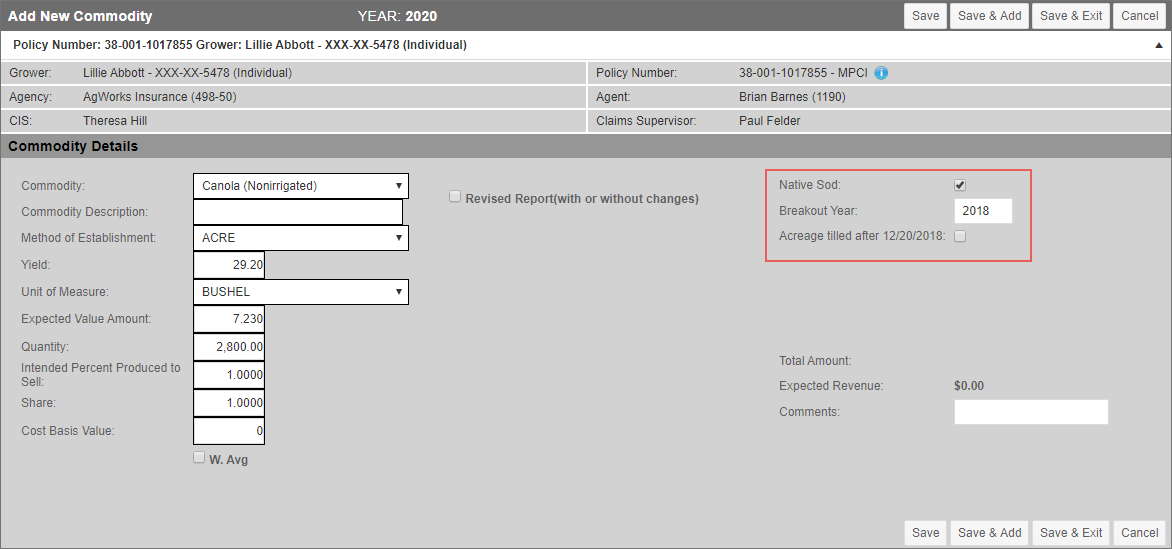Related
Native Sod
Overview
Native Sod is acreage (>5 acres) that has never been tilled or where the producer cannot substantiate the ground has even been tilled for the production of an annual crop for select states and plans.
Native Sod procedures were originally implemented as part of the 2014 Farm Bill changes and revised with the 2018 Farm Bill.
| • | Under the 2014 Farm Bill: Any ground tilled after February 7th, 2014 receives reduced approved and rate yields at 65% of the t-yield. In addition, a 50%-point reduction in the applicable premium subsidy applies and a Program Indicator Code of "NS" is sent on the P11 record. |
| • | These procedures apply until four years of planting have occurred on the Native Sod ground, regardless of insurability. |
| • | Under the 2018 Farm Bill: Any ground tilled after December 20, 2018 is subject to the same reduced approved and rate yields of 65% of the t-yield and a 50%-point reduction in the applicable premium subsidy and a Program Indicator Code of "N8" is sent on the P11 record. |
| • | However, these procedures apply until four years of planting an insured crop have occurred on the Native Sod ground. |
| • | If the ground is not planted to an insurable crop for four years, then the Native Sod procedures apply for the first 10 crop years after the initial tillage of the Native Sod ground. |
Consult the actuarial documents for Native Sod availability and Sales Closing Dates by state/county/crop. For additional specifics regarding these guidelines, see the RMA site page for the Native Sod Fact Sheet.
Native Sod procedures are applied with a Written Agreement. Depending on the acreage, the Written Agreement will be either an "NB - New Breaking Land" or an "99 - Internal Type, Practice, Price, Rate or Option Override" Request Type. The 99 Type is reserved for Native Sod acreage that can be approved by the AIP and does not need to be approved by the RMA for insurability.
NOTE: The availability of the "99 - Internal" in the Request Type dropdown depends on your permissions.
There are 4 steps in applying Native Sod procedures to a coverage:
When a Native Sod WA exists on the coverage and the WA detail lines have been attached to the MPCI detail lines, the APH displays as follows:
| a. | The Procedure Number displays the Procedure Code of “D”; |
| b. | The Yield Indicator is “SB” to indicate Native Sod (but when the ground was tilled after December, 20th 2018, this indicator code is "N8"); |
| c. | The Current Year Yld Limitation code is “04”; and |
| d. | The Rate Yield and Approved Yield are set to 65 % of the t-yield. |
NOTE: YA, TA, SA, t-yields, MYs, and New Producer will not be applicable. If these overrides are selected on the APH, upon save, a warning is displayed in the top-left corner.
The Native Sod Procedure Code of "D" is available from the Procedure Code dropdown on the Fast Edit AR and Fast Edit APH pages when applicable to the State/County/Crop. With this, the description popup that displays when a user hovers over the BU Override column has been updated:
| • | Fast Edit AR: "D- Uninsurable Native Sod Acreage (> 5 acres) and is not insured by Special Provisions or WA" |
| • | Fast Edit PR: "D- Native Sod (1st 4 years of planting – acreage tilled after 02-07-2014)" |
WFRP
For the 2020+ RYs, when adding a Commodity for a WFRP policy, Native Sod-related checkboxes display:
Initially, only two checkboxes display. Depending on which, if any, Native Sod selection is made, the System will display additional checkboxes:
| • | Native Sod checkbox: Designates the WFRP Commodity's acreage as Native Sod. When selected, the System will also display a Breakout Year textbox. When the Breakout Year is "2018", the System displays a Tilled After 12/20/2018 checkbox, so you can designate whether the acreage falls under the 2014 or 2018 Farm Bill's Native Sod procedures. |
| • | De Minimus Native Sod checkbox: Designates the WFRP Commodity's acreage as being less than 5 acres , falling under the de minimis 5-acre exemption. |

